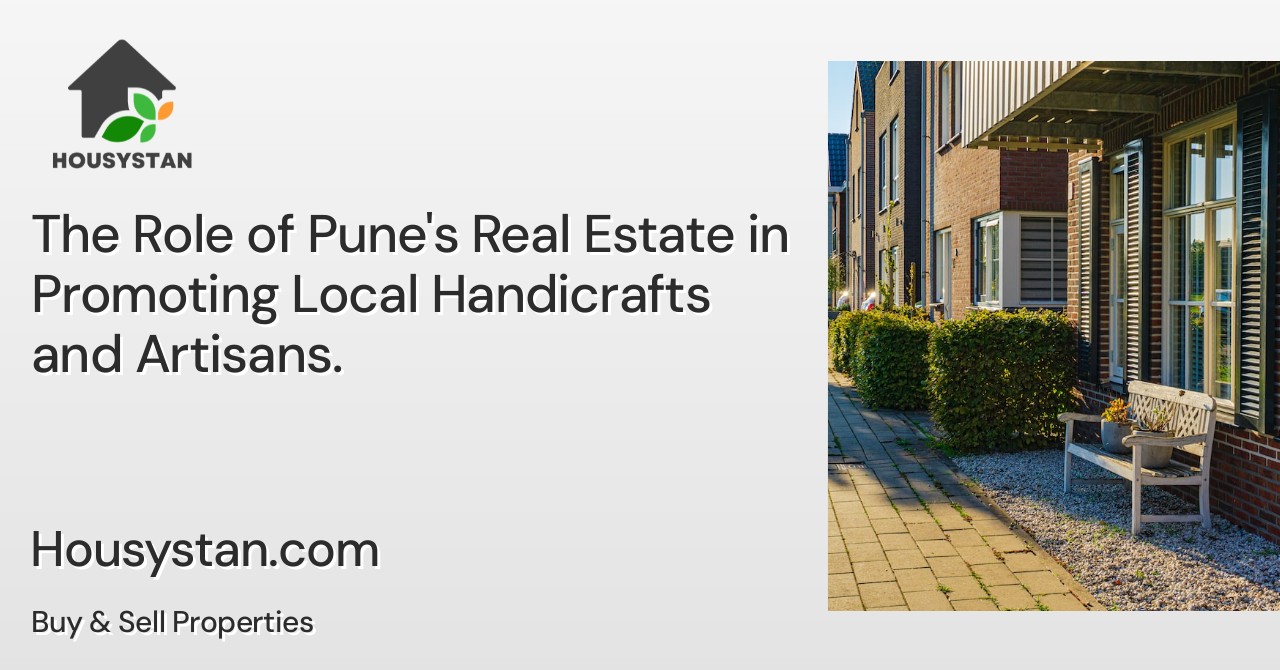The Role of Pune's Real Estate in Promoting Local Handicrafts and Artisans
Read latest blogs and articles from Housystan

The Information mentioned here was last updated on:
31/12/2025Pune's Real Estate: A Boost for Local Handicrafts and Artisans
Nestled amidst the Western Ghats, Pune is a city that has steadily grown into a bustling urban hub, attracting people from all over the country. While it's known for its educational institutions and vibrant culture, Pune's real estate sector has been playing a quieter yet significant role in promoting local handicrafts and artisans. The intersection of real estate development and the handicraft industry is proving to be a win-win, providing new platforms for traditional artisans to showcase their work.
Pune’s Real Estate Boom
- Verified Tenants/Buyers
- Unlimited Property Listing
- Zero subscription/charges fee
Over the past few decades, Pune has witnessed significant real estate growth. The city’s strategic location, favorable climate, and proximity to Mumbai have led to a surge in demand for residential, commercial, and industrial spaces. These developments are not just physical structures; they are vibrant ecosystems that integrate culture, commerce, and community.
Real estate developers in Pune have recognized the intrinsic value local culture adds to properties. Whether it’s residential complexes, shopping malls, or office spaces, incorporating elements of local culture has become a selling point. This modern appreciation for local aesthetic and cultural narratives has helped create opportunities for artisans and craftspeople to showcase their work.
Real Estate as Display Platforms
Shopping malls and commercial complexes in Pune have become prominent platforms for showcasing handicrafts. By hosting fairs and exhibitions, malls like Phoenix Marketcity and Amanora Town Centre offer artisans a space to reach urban consumers who may not typically encounter traditional crafts. This exposure is crucial for artisans as it provides them with direct access to new markets, allowing them to gauge consumer preferences and adjust their offerings accordingly.
Moreover, real estate developers often incorporate local art into their projects. This includes everything from intricate Warli paintings adorning the lobby of a corporate building to beautifully crafted sculptures gracing the gardens of a residential complex. Such integrations give artisans a chance to display their skills and provide residents and visitors with a deeper appreciation for local culture.
Community Spaces and Local Markets
Another way Pune’s real estate has supported artisans is by facilitating the development of community spaces and local markets. These areas serve as a crossroads where tradition and modernity meet, providing artisans a platform to directly sell their goods. The trend of including local handicraft markets within residential complexes is gaining traction. These markets help residents engage with local artisans directly, creating a sense of community and cultural exchange.
Such initiatives are not only beneficial for artisans but also for residents, who gain access to unique products that carry cultural and artistic significance. It also elevates the appeal of these living spaces, making them more attractive to potential buyers who value cultural enrichment.
Supporting Sustainable Practices
The partnership between real estate developers and artisans promotes sustainable practices as well. Many developers in Pune are increasingly interested in sustainable and eco-friendly building practices. This interest naturally extends to supporting artisans who use traditional, sustainable methods to create their goods.
Handicrafts made from natural materials such as bamboo, clay, and organic fibers align well with eco-friendly building initiatives. As more consumers demand sustainable living options, integrating traditional crafts into the design and function of real estate projects helps meet this demand while supporting and preserving local craftsmanship.
Enhancing Tourism through Artisanal Experiences
Tourism plays a significant role in Pune’s economy, and the integration of local handicrafts into real estate developments helps boost this sector. Visitors are often drawn to experiences that offer authentic glimpses into local culture, and artisans provide just that through their crafts. By featuring local artistry in tourist-centric real estate projects such as hotels, cultural centers, and marketplaces, Pune’s real estate is adding a new dimension to tourism in the region—a handmade and heartfelt one.
Tourists staying in Pune are more likely to purchase handmade souvenirs when these items are available and curated within their accommodations or nearby. This has also led to an increase in workshops where guests can learn traditional crafts, creating memorable experiences that enhance the city's tourism appeal while providing additional income streams for artisans.
Challenges and the Road Ahead
Despite the significant strides made, there are challenges that both real estate developers and artisans face. The cultural commodification of crafts is a concern, where traditional items risk being turned into mere decorative pieces, losing their cultural essence. Real estate developers must work closely with artisans to ensure authenticity is preserved and valued.
Furthermore, the seasonal nature of handicraft markets and exhibitions can lead to irregular income for artisans. Continuous support from developers in the form of permanent exhibition spaces and promotional events can help create a more sustainable ecosystem.
As Pune's real estate continues to grow, the integration of local artisans and their crafts offers a promising pathway for economic development that honors cultural heritage. By maintaining this synergy, the city can ensure that its growth is inclusive, sustainable, and culturally rich, providing benefits not just for real estate stakeholders but for the entire community.